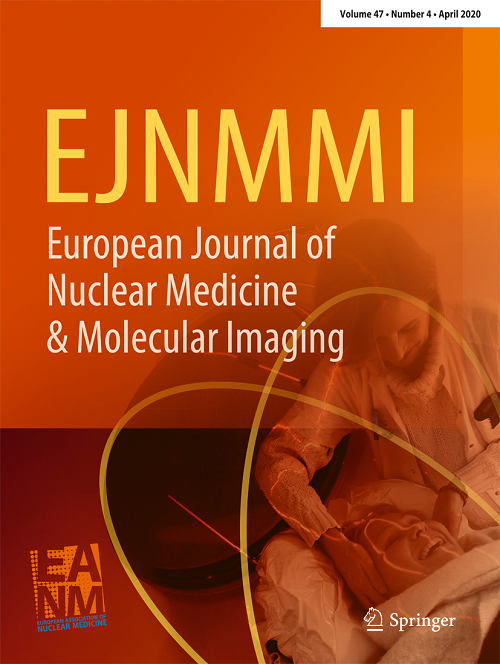Bone marrow scintigraphy as a prognostic marker of overall survival in mCRPC patients treated with Radium-223 dichloride.
IF 7.6
1区 医学
Q1 RADIOLOGY, NUCLEAR MEDICINE & MEDICAL IMAGING
European Journal of Nuclear Medicine and Molecular Imaging
Pub Date : 2025-09-25
DOI:10.1007/s00259-025-07589-1
引用次数: 0
Abstract
PURPOSE To evaluate the potential prognostic value of pretherapeutic Bone Marrow Scintigraphy (BMS) in metastatic castration-resistant prostate cancer (mCRPC) patients treated with Ra-223 dichloride (Ra-223). METHODS We analyzed 28 mCRPC patients who performed BMS and treated with Ra-223. Visual image analysis was performed and defined as follows: normal distribution (uptake in the vertebral column and bony pelvis) vs. medullary expansion (uptake at the distal half of femoral and/or humeral diaphysis or more distally). Correlation between medullary expansion status and baseline laboratory factors was performed. Survival analyses for evaluating the association between medullary expansion and other variables with overall survival (OS) were conducted using cox regression hazard model and Kaplan Meier methods. RESULTS A total of 130 doses of Ra-223 were administered, with 17 (60%) patients received 6 cycles. BMS status was significantly correlated with hemoglobin levels (p < 0.001), PSA levels (p = 0.008), the number of prior systemic therapies (p = 0.032) and radiotherapy (p = 0.01). Median OS was 19 months, with 16 patients dead. Among variables tested, BMS status, hemoglobin, number of therapies, and number of Ra-223 cycles were significantly associated with OS (hazard ratios: 3.3, p = 0.02; 0.75, p = 0.042; 1.74, p = 0.019; 4.6, p = 0.006; respectively). Patients with normal BMS had a median OS of 33 months vs. 7.6 months in those with medullary expansion (log-rank 5.5, p = 0.019). CONCLUSION This study demonstrated a significant association between medullary expansion status on BMS and OS in mCRPC patients treated with Ra-223. Patients exhibiting medullary expansion have worse outcomes compared to those without expansion. Medullary expansion was correlated with adverse prognostic biomarkers commonly linked to worse outcomes in mCRPC.骨髓显像作为mCRPC患者接受223二氯化镭治疗后总生存期的预后标志物。
目的探讨治疗前骨髓显像(BMS)对转移性去势抵抗性前列腺癌(mCRPC)患者应用Ra-223二氯(Ra-223)治疗的潜在预后价值。方法对28例行BMS并接受Ra-223治疗的mCRPC患者进行分析。进行视觉图像分析并定义如下:正态分布(在脊柱和骨盆摄取)vs.髓质扩张(在股骨和/或肱骨骨干远端或更远端摄取)。观察骨髓扩张状态与基线实验室因素的相关性。采用cox回归风险模型和Kaplan Meier方法进行生存分析,以评估髓质扩张和其他变量与总生存(OS)之间的关系。结果Ra-223共给药130次,17例(60%)患者接受6个周期。BMS状态与血红蛋白水平(p < 0.001)、PSA水平(p = 0.008)、既往全身治疗次数(p = 0.032)和放疗(p = 0.01)显著相关。中位生存期为19个月,死亡16例。在测试的变量中,BMS状态、血红蛋白、治疗次数和Ra-223周期数与OS显著相关(风险比分别为3.3,p = 0.02; 0.75, p = 0.042; 1.74, p = 0.019; 4.6, p = 0.006)。BMS正常患者的中位OS为33个月,而髓质扩张患者的中位OS为7.6个月(log-rank为5.5,p = 0.019)。结论本研究表明,Ra-223治疗的mCRPC患者BMS的髓质扩张状态与OS之间存在显著关联。髓质扩张患者的预后较无扩张患者差。髓质扩张与不良预后生物标志物相关,通常与mCRPC的不良预后相关。
本文章由计算机程序翻译,如有差异,请以英文原文为准。
求助全文
约1分钟内获得全文
求助全文
来源期刊
CiteScore
15.60
自引率
9.90%
发文量
392
审稿时长
3 months
期刊介绍:
The European Journal of Nuclear Medicine and Molecular Imaging serves as a platform for the exchange of clinical and scientific information within nuclear medicine and related professions. It welcomes international submissions from professionals involved in the functional, metabolic, and molecular investigation of diseases. The journal's coverage spans physics, dosimetry, radiation biology, radiochemistry, and pharmacy, providing high-quality peer review by experts in the field. Known for highly cited and downloaded articles, it ensures global visibility for research work and is part of the EJNMMI journal family.

 求助内容:
求助内容: 应助结果提醒方式:
应助结果提醒方式:


